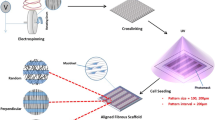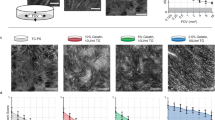Abstract
Micropatterning and microfabrication techniques have been widely used to pattern cells on surfaces and to have a deeper insight into many processes in cell biology such as cell adhesion and interactions with the surrounding environment. The aim of this study was the development of an easy and versatile technique for the in vitro production of arrays of functional cardiac and skeletal muscle myofibers using micropatterning techniques on soft substrates. Cardiomyocytes were used for the production of oriented cardiac myofibers whereas mouse muscle satellite cells for that of differentiated parallel myotubes. We performed micro-contact printing of extracellular matrix proteins on soft polyacrylamide-based hydrogels photopolymerized onto functionalized glass slides. Our methods proved to be simple, repeatable and effective in obtaining an extremely selective adhesion of both cardiomyocytes and satellite cells onto patterned soft hydrogel surfaces. Cardiomyocytes resulted in aligned cardiac myofibers able to exhibit a synchronous contractile activity after 2 days of culture. We demonstrated for the first time that murine satellite cells, cultured on a soft hydrogel substrate, fuse and form aligned myotubes after 7 days of culture. Immunofluorescence analyses confirmed correct expression of cell phenotype, differentiation markers and sarcomeric organization. These results were obtained in myotubes derived from satellite cells from both wild type and MDX mice which are research models for the study of muscle dystrophy. These arrays of both cardiac and skeletal muscle myofibers could be used as in vitro models for pharmacological screening tests or biological studies at the single fiber level.








Similar content being viewed by others
References
D.R. Albrecht, V.L. Tsang, R.L. Sah, S.N. Bathia, Photo- and electropatterning of hydrogel-encapsulated living cell arrays Lab Chip 5, 111–118 (2005). doi:10.1039/b406953f
D.R. Albrecht, G.H. Underhill, T.B. Wassermann, R.L. Sah, S.N. Bhatia, Probing the role of multicellular organization in three-dimensional microenvironments Nat. Methods 3(5), 369–375 (2006). doi:10.1038/nmeth873
L. Almany, D. Seliktar, Biosynthetic hydrogel scaffolds made from fibrinogen and polyethylene glycol for 3D cell cultures Biomaterials 26, 2467–2477 (2005). doi:10.1016/j.biomaterials.2004.06.047
K. Britton-Keys, F.M. Andreopoulos, N. Peppas, Poly(ethylene glycol) star polymer hydrogels Macromolecules 31, 8149–8156 (1998). doi:10.1021/ma980999z
S.B. Brueggemeier, D. Wu, S.J. Kron, S.P. Palecek, Protein-acrylamide copolymer hydrogels for array-based detection of tyrosine kinase activity from cell lysates Biomacromol 6, 2765–2775 (2005). doi:10.1021/bm050257v
J.A. Burdick, A. Khademhosseini, R. Langer, Fabrication of gradient hydrogels using a microfluidics/photopolymerization process Langmuir 20, 5153–5156 (2004). doi:10.1021/la049298n
D.S. Chen, M.M. Davis, Molecular and functional analysis using live cell microarrays Curr. Opin. Chem. Biol 10(1), 28–34 (2006). doi:10.1016/j.cbpa.2006.01.001
D.S. Chen, Y. Soen, M.M. Davis, P.O. Brown, Functional and molecular profiling of heterogeneous tumor samples using a novel cellular microarray J. Clin. Oncol 22, 9507 (2004). doi:10.1200/JCO.2004.09.062
A. Engler, L. Bacakova, C. Newman, A. Hategan, M. Griffin, D. Discher, Substrate compliance versus ligand density in cell on gel responses Biophys. J 86, 617–628 (2004b)
A.J. Engler, M.A. Griffin, S. Sen, C.G. Bönnemann, H. LeeSweeney, D.E. Discher, Myotubes differentiate optimally on substrates with tissue-like stiffness: pathological implications for soft or stiff microenvironments J. Cell Biol. 166, 877–887 (2004a). doi:10.1083/jcb.200405004
D. Falconnet, G. Csucs, H.M. Grandin, M. Textor, Surface engineering approaches to micropattern surfaces for cell-based assays Biomaterials 27, 3044–3063 (2006). doi:10.1016/j.biomaterials.2005.12.024
C.J. Flaim, S. Chien, S.N. Bhatia, An extracellular matrix microarray for probing cellular differentiation Nat. Methods 2, 119–125 (2005). doi:10.1038/nmeth736
S.M. Gopalan, C. Flaim, S.N. Bhatia, M. Hoshijima, R. Knoell, K.R. Chien et al., Anisotropic stretch-induced hypertrophy in neonatal ventricular myocytes micropatterned on deformable elastomers Biotechnol. Bioeng 81(5), 578–587 (2003). doi:10.1002/bit.10506
D. Hern, J.A. Hubbell, Incorporation of adhesion peptides into nonadhesive hydrogels useful for tissue resurfacing J. Biomed. Mater. Res 39, 266–276 (1998). doi:10.1002/(SICI)1097-4636(199802)39:2<266::AID-JBM14>3.0.CO;2-B
D.E. Ingber, Mechanical signaling and the cellular response to extracellular matrix in angiogenesis and cardiovascular physiology Circ. Res 91(10), 877–887 (2002). doi:10.1161/01.RES.0000039537.73816.E5
D.E. Ingber, Mechanical control of tissue growth: function follows form Proc. Natl. Acad. Sci. USA 102(33), 11571–11572 (2005). doi:10.1073/pnas.0505939102
J.H. Jang, D.V. Schaffer, Microarraying the cellular microenvironment Mol. Syst. Biol. 2(39) (2006)
D. Kaplan, R.T. Moon, G. Vunjak-Novakovic, It takes a village to grow a tissue Nat. Biotechnol 23(10), 1237–1239 (2005). doi:10.1038/nbt1005-1237
J.M. Karp, Y. Yeo, W. Geng, C. Cannizarro, K. Yan, D.S. Kohane et al., A photolithographic method to create cellular micropatterns Biomaterials 27, 4755–4764 (2006). doi:10.1016/j.biomaterials.2006.04.028
A. Khademhosseini, G. Eng, J. Yeh, P.A. Kucharczyk, R. Langer, G. Vunjak-Novakovic et al., Microfluidic patterning for fabrication of contractile cardiac organoids Biomed. Microdevices 9, 149–157 (2007). doi:10.1007/s10544-006-9013-7
C.B. Khatiwala, S.R. Peyton, A.J. Putnam, Intrinsic mechanical properties of the extracellular matrix affect the behavior of pre-osteoblastic MC3T3-E1 cells Am. J. Physiol. Cell Physiol 290(6), C1640–C1650 (2006). doi:10.1152/ajpcell.00455.2005
A. Kozarova, S. Petrinac, A. Ali, J.W. Hudson, Array of informatics: applications in modern research J. Proteome Res 5(5), 1051–1059 (2006). doi:10.1021/pr050432e
J.B. Leach, K.A. Bivens, C.W. Patrick, C.E. Schmidt, Photocrosslinked hyaluronic acid hydrogels: natural, biodegradable tissue engineering scaffolds Biotechnol. Bioeng. 82, 578–5 (2003). doi:10.1002/bit.10605
J.B. Leach, C.E. Schmidt, Characterization of protein release from photocrosslinkable hyaluronic acid–polyethylene glycol hydrogel tissue engineering scaffolds Biomaterials 26, 125–135 (2005). doi:10.1016/j.biomaterials.2004.02.018
S. Lin-Gibson, R.L. Jones, N.R. Washburn, F. Horkay, Structure–property relationships of photopolymerizable poly(ethylene glycol) dimethacrylate hydrogels Macromolecules 38, 2897–2902 (2005). doi:10.1021/ma0487002
S. Machida, E.E. Spangenburg, F.W. Booth, Primary rat muscle progenitor cells have decreased proliferation and myotube formation during passages Cell Prolif 37, 267–277 (2004). doi:10.1111/j.1365-2184.2004.00311.x
T.C. McDevitt, J.C. Angello, M.L. Whitney, H. Reinecke, S.D. Hauschka, C.E. Murry et al., In vitro generation of differentiated cardiac myofibers on micropatterned laminin surfaces J. Biomed. Mater. Res 60, 472–479 (2002). doi:10.1002/jbm.1292
T.C. McDevitt, K.A. Woodhouse, S.D. Hauschka, C.E. Murry, Spatially organized layers of cardiomyocytes on biodegradable polyurethane films for myocardial repair J. Biomed. Mater. Res. 66A, 586–595 (2003). doi:10.1002/jbm.a.10504
D. Motlagh, S.E. Senyo, T.A. Desai, B. Russell, Microtextured substrata alter gene expression, protein localization and the shape of cardiac myocytes Biomaterials 24(14), 2463–2476 (2003)
A. Pedram, M. Razandi, M. Aitkenhead, E.R. Levin, Estrogen inhibits cardiomyocyte hypertrophy in vitro. Antagonism of calcineurin-related hypertrophy through induction of MCIP1 J. Biol. Chem 280(28), 26339–26348 (2005). doi:10.1074/jbc.M414409200
S.R. Peyton, A.J. Putnam, Extracellular matrix rigidity governs smooth muscle cell motility in a biphasic fashion J. Cell. Physiol 204, 198–209 (2005). doi:10.1002/jcp.20274
S. Rohr, D.M. Scholly, A.G. Kleber, Patterned growth of neonatal rat heart cells in culture. Morphological and electrophysiological characterization Circ. Res 68, 114–130 (1991)
J.D. Rosenblatt, A.I. Lunt, D.J. Parry, T.A. Partridge, Culturing satellite cells from living single muscle fiber explants In Vitro Cell. Dev. Biol. Anim 31, 773–779 (1995). doi:10.1007/BF02634119
S.A. Ruiz, C.S. Chen, Microcontact printing: A tool to pattern Soft Matter 3, 1–11 (2007). doi:10.1039/b613349e
D.W. Speicher, R.L. McCarl, Pancreatic enzyme requirements for the dissociation of rat hearts for culture In Vitro 10, 30–41 (1974). doi:10.1007/BF02615336
K.Y. Suh, J. Seong, A. Khademhosseini, P.E. Laibinis, R. Langer, A simple soft lithographic route to fabrication of poly(ethylene glycol) microstructures for protein and cell patterning Biomaterials 25, 557–563 (2004). doi:10.1016/S0142-9612(03)00543-X
R.B. Vernon, M.D. Gooden, S.L. Lara, T.N. Wight, Microgrooved fibrillar collagen membranes as scaffolds for cell support and alignment Biomaterials 26, 3131–3140 (2005). doi:10.1016/j.biomaterials.2004.08.011
G. Vunjak-Novakovic, L.E. Freed, Culture of organized cell communities Adv. Drug Deliv. Rev 33(1–2), 15–30 (1998). doi:10.1016/S0169-409X(98)00017-9
Y. Xia, G.M. Whitesides, Soft lithography Angew. Chem. Int. Ed 37, 550–575 (1998). doi:10.1002/(SICI)1521-3773(19980316)37:5<550::AID-ANIE550>3.0.CO;2-G
Y.F. Xiao, A.M. Gomez, J.P. Morgan, W.J. Lederer, A. Leaf, Suppression of voltage-gated L-type Ca2+ currents by polyunsaturated fatty acids in adult and neonatal rat ventricular myocytes Proc. Natl. Acad. Sci. USA 94(8), 4182–4187 (1997). doi:10.1073/pnas.94.8.4182
E.K.F. Yim, R.M. Reano, S.W. Pang, A.F. Yee, C.S. Chen, K.W. Leon, Nanopattern-induced changes in morphology and motility of smooth muscle cells Biomaterials 26, 5405–5413 (2005). doi:10.1016/j.biomaterials.2005.01.058
Acknowledgement
This work was supported by MIUR, University of Padua, Regione Veneto (Azione biotech II), Città della Speranza.
Author information
Authors and Affiliations
Corresponding author
Electronic supplementary material
Below is the link to the electronic supplementary material.
Fig. S1
Satellite cells growing onto stiff micropatterned hydrogel surfaces. 20x magnification. Satellite cells were seeded onto stiffer hydrogels, deriving from a 20% solution of acrylamide/bis-acrylamide in PBS (v/v). From an immunostaining for Myosin Heavy Chain (panel A), we can observe how the myotubes formed after 7 days of culture, did not possess a sarcomeric organization and were smaller than those formed on softer (10%) hydrogels, where the characteristic striations are usually observable even at 20x magnification (GIF 240 KB)
Fig. S1
High resolution image file (TIF 1.54 MB).
Fig. S2
Satellite cells growing onto uniformly coated hydrogel surfaces. After 12 days in culture, satellite cells, originally seeded at the same cell density used for micropatterned hydrogels, started to fuse, forming randomly oriented myotubes (GIF 224 KB)
Fig. S2
High resolution image file (TIF 1.81 MB).
Fig. S3
Cardiomyocytes growing onto uniformly coated hydrogel surfaces. After 10 days in culture, cardiomyocytes, originally seeded at the same cell density used for micropatterned hydrogels, started to randomly cluster into un-synchronous contracting structures. Scale bar 50 µm (GIF 768 KB)
Fig. S2
High resolution image file (TIF 4.50 MB).
Rights and permissions
About this article
Cite this article
Cimetta, E., Pizzato, S., Bollini, S. et al. Production of arrays of cardiac and skeletal muscle myofibers by micropatterning techniques on a soft substrate. Biomed Microdevices 11, 389–400 (2009). https://doi.org/10.1007/s10544-008-9245-9
Published:
Issue Date:
DOI: https://doi.org/10.1007/s10544-008-9245-9




